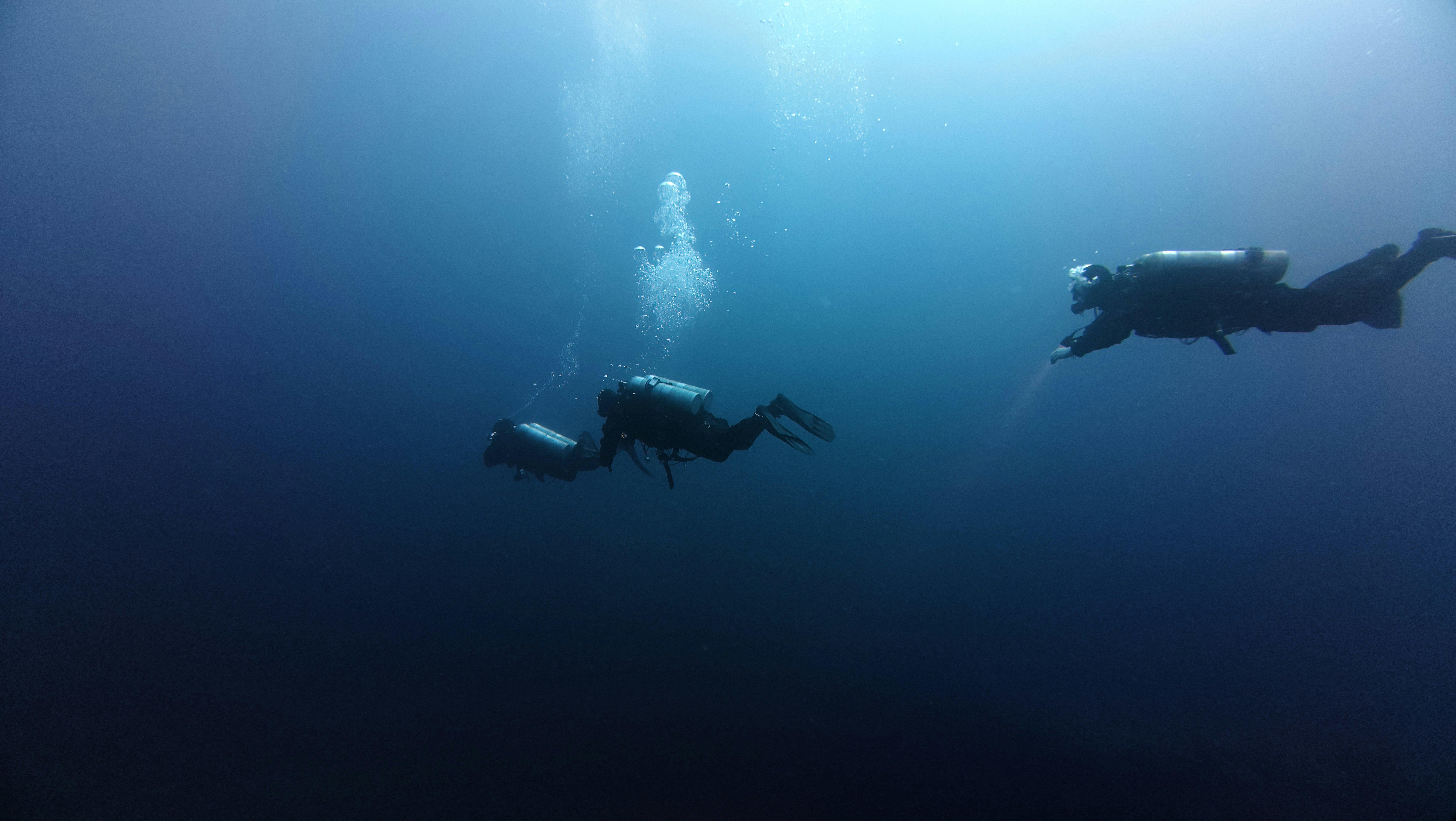Exploring the Depths: The Intricate World of Cave Diving
Plunging into the unknown, cave divers navigate submerged labyrinths where darkness reigns supreme. This extreme sport challenges human limits, combining technical diving skills with spelunking expertise. As we delve into the captivating realm of cave diving, we'll uncover its history, techniques, and the unique ecosystem it reveals, while examining the physical and psychological demands placed on its practitioners.

The Origins of Cave Diving
Cave diving traces its roots back to the early 20th century when intrepid explorers first ventured into flooded caverns. Initially, these expeditions were driven by scientific curiosity and the desire to map underground water sources. The sport gained momentum in the 1950s and 1960s, particularly in Florida, where the abundance of natural springs and underwater cave systems provided ideal conditions for exploration.
Early cave divers faced enormous risks due to limited equipment and a lack of established safety protocols. Many of these pioneers used adapted open-water scuba gear, which was ill-suited for the unique challenges of cave environments. The dangers were underscored by a series of tragic accidents, highlighting the need for specialized training and equipment.
As the sport evolved, so did the technology and techniques. The introduction of side-mount configurations, rebreathers, and cave-specific dive computers revolutionized the way divers approached these challenging environments. These advancements, coupled with rigorous training standards developed by organizations like the National Speleological Society-Cave Diving Section (NSS-CDS) and the Cave Diving Group (CDG), have significantly improved safety and expanded the boundaries of exploration.
The Technical Aspects of Cave Diving
Cave diving demands a level of technical proficiency far beyond that required for open-water diving. Divers must master a range of specialized skills and equipment to navigate the unique challenges posed by overhead environments. One of the most critical aspects is gas management, as divers must carry all the air they need for the entire dive, including reserves for emergencies and decompression stops.
Proper buoyancy control is paramount in cave diving. Divers must maintain neutral buoyancy to avoid disturbing silt on the cave floor, which can lead to dangerous low-visibility situations. They also need to master specialized finning techniques, such as the frog kick and helicopter turn, to maneuver efficiently in tight spaces without stirring up sediment.
Navigation in caves presents another significant challenge. Unlike open water, where divers can simply ascend to the surface if they become disoriented, cave divers must rely on guideline systems to find their way back to the entrance. These guidelines are meticulously laid and maintained, serving as lifelines in the complex maze-like structure of many cave systems.
Equipment configuration is tailored to the unique demands of cave diving. Redundancy is key, with divers carrying multiple light sources, regulators, and often independent gas supplies. Side-mount or back-mount configurations allow for streamlined profiles, essential for squeezing through narrow passages. Drysuits are often preferred for thermal protection in the cold waters typical of many cave environments.
The Physical and Psychological Demands
Cave diving is not for the faint of heart. It requires a combination of physical fitness, mental resilience, and unwavering focus. The physical demands are substantial, with divers often having to swim long distances while carrying heavy equipment. Core strength and flexibility are crucial for maneuvering through tight spaces and maintaining proper body position.
The psychological aspect of cave diving is equally challenging. Divers must remain calm and focused in an environment that can be inherently claustrophobic and disorienting. The absolute darkness, broken only by artificial light, can be unsettling even for experienced divers. Decision-making under pressure is critical, as seemingly minor issues can quickly escalate into life-threatening situations in the confined space of a cave.
Training for cave diving is rigorous and ongoing. Divers must progress through a series of certifications, each building on the skills and knowledge of the previous level. This training emphasizes not only technical skills but also the development of a safety-first mindset and the ability to problem-solve in high-stress situations.
The mental preparation for cave diving extends beyond the dive itself. Detailed planning is essential, with divers meticulously calculating gas consumption rates, decompression schedules, and contingency plans. This level of preparation helps mitigate risks and builds confidence, allowing divers to focus on the task at hand when underwater.
Scientific Contributions and Discoveries
While cave diving originated as an adventurous pursuit, it has evolved into a valuable tool for scientific research. Cave divers have played a crucial role in advancing our understanding of geology, hydrology, and paleontology. The unique conditions in underwater caves often preserve evidence of past climates and extinct species, providing a window into Earth’s history.
One of the most significant contributions of cave diving to science has been in the field of karst hydrology. By exploring and mapping underwater cave systems, divers have helped scientists understand the complex flow of groundwater through limestone formations. This knowledge is crucial for water resource management and environmental protection, particularly in regions that rely heavily on aquifers for their water supply.
Cave diving has also led to remarkable paleontological discoveries. In Mexico’s Yucatan Peninsula, cave divers have uncovered the remains of extinct megafauna and early human inhabitants in submerged caves. These finds, including the nearly complete skeleton of a teenage girl dubbed “Naia,” have provided invaluable insights into the peopling of the Americas and the fauna that existed during the last ice age.
In addition to these historical insights, cave diving expeditions have revealed previously unknown species adapted to life in these dark, nutrient-poor environments. These discoveries challenge our understanding of biodiversity and the limits of life on Earth. From translucent cave fish to unique microorganisms, the inhabitants of these submerged caves offer a glimpse into the extraordinary adaptability of life.
Environmental Conservation and Cave Ecology
As cave diving has grown in popularity, so too has awareness of the fragile nature of cave ecosystems. These environments, often isolated for millennia, are incredibly sensitive to disturbance. The increased human presence in caves has raised concerns about potential impacts on water quality, sediment disturbance, and the delicate balance of cave-dwelling organisms.
Responsible cave diving practices now emphasize conservation alongside exploration. Many cave diving organizations have implemented strict guidelines to minimize environmental impact. These include restrictions on touching cave formations, proper waste management, and limitations on the use of lights to protect light-sensitive organisms.
Cave divers have also become important advocates for the protection of these unique ecosystems. By documenting the beauty and scientific value of underwater caves, they have helped raise public awareness and support for conservation efforts. In many cases, the data collected by cave divers has been instrumental in securing protected status for vulnerable cave systems.
The study of cave ecology has emerged as a distinct field, with cave divers often working alongside scientists to monitor environmental conditions and document cave-dwelling species. This collaboration has led to a better understanding of the interconnectedness of surface and subsurface ecosystems, highlighting the importance of protecting entire watersheds to preserve cave environments.
Technological Advancements in Cave Diving
The evolution of cave diving technology has been driven by the need for increased safety, efficiency, and exploration capabilities. Recent years have seen a surge in innovations that are pushing the boundaries of what’s possible in underwater cave exploration.
Rebreather technology has revolutionized cave diving by allowing for longer bottom times and reduced decompression obligations. These closed-circuit systems recycle exhaled breath, removing carbon dioxide and adding oxygen as needed. This not only extends dive times but also reduces the amount of gas that needs to be carried, allowing divers to explore further into cave systems.
Underwater propulsion vehicles (DPVs) have greatly extended the range of cave diving expeditions. These battery-powered scooters allow divers to cover large distances with minimal exertion, conserving energy and gas for the most challenging parts of the dive. Advanced models are designed specifically for cave environments, with streamlined profiles and adjustable buoyancy.
Improvements in lighting technology have dramatically enhanced visibility and safety in cave diving. LED lights now provide powerful, reliable illumination with long battery life. Some advanced systems even offer variable beam patterns, allowing divers to adjust their light for different situations, from wide-angle illumination of large chambers to focused beams for reading instruments or examining formations up close.
Cave mapping technology has also seen significant advancements. 3D scanning and photogrammetry techniques now allow for incredibly detailed and accurate mapping of cave systems. These digital models not only aid in navigation and planning but also provide valuable data for scientific research and conservation efforts.
Communication systems designed for use in overhead environments have improved safety and coordination among dive teams. Through-water communication devices allow divers to stay in contact over short distances, while more advanced systems can transmit data to surface support teams, providing real-time monitoring of diver status and location.
Training and Safety Protocols
The development of standardized training and safety protocols has been crucial in reducing the risks associated with cave diving. Organizations like the Cave Diving Section of the National Speleological Society (NSS-CDS) and the International Association of Nitrox and Technical Divers (IANTD) have established comprehensive training programs that cover every aspect of cave diving.
These training programs typically follow a progressive structure, starting with cavern diving and gradually introducing more advanced skills and techniques. Key components include gas management, line laying and following, emergency procedures, and equipment handling. Emphasis is placed on developing a conservative, safety-first mindset and the ability to make sound decisions under pressure.
One of the most important safety protocols in cave diving is the “rule of thirds.” This rule dictates that divers should use no more than one-third of their gas supply for the outward journey, reserving one-third for the return and one-third for emergencies. This conservative approach ensures that divers have ample reserves in case of unexpected delays or complications.
Another critical safety measure is the use of continuous guideline systems. These lines, carefully laid and maintained by experienced divers, provide a tactile connection to the cave entrance. Proper line management skills, including the ability to follow a line by touch in zero visibility conditions, are essential for safe cave diving.
Pre-dive planning and briefings are given heightened importance in cave diving. Teams meticulously plan their dives, discussing objectives, potential hazards, and emergency procedures. This planning extends to detailed gas calculations, taking into account the specific characteristics of the cave system and the planned dive profile.
Post-dive debriefings are equally important, allowing teams to review their performance, discuss any issues encountered, and identify areas for improvement. This continuous learning process is essential for maintaining and enhancing safety standards in the sport.
The Future of Cave Diving
As technology continues to advance and our understanding of cave environments deepens, the future of cave diving looks both exciting and challenging. Emerging technologies like augmented reality (AR) dive masks could revolutionize navigation and data presentation underwater, providing real-time information on dive parameters, navigation, and even highlighting points of scientific interest.
The integration of artificial intelligence and machine learning into dive computers and rebreathers may lead to more sophisticated gas management systems and predictive models for decompression. These advancements could potentially extend dive times and improve safety margins, allowing for even more ambitious explorations.
Remote operated vehicles (ROVs) and autonomous underwater vehicles (AUVs) are likely to play an increasing role in cave exploration. These devices can scout ahead of divers, mapping passages and identifying potential hazards. In some cases, they may be able to explore areas too narrow or dangerous for human divers, expanding our knowledge of cave systems without putting lives at risk.
Climate change presents both opportunities and challenges for cave diving. Rising sea levels may flood previously dry cave systems, opening up new areas for exploration. However, these changes also pose risks to existing cave ecosystems and may alter water chemistry and flow patterns in ways that impact diving conditions.
The growing interest in space exploration and the search for extraterrestrial life may also influence the future of cave diving. The techniques and technologies developed for exploring underwater caves on Earth could prove valuable in the exploration of subterranean oceans on moons like Europa or Enceladus. Cave divers’ experience in operating in extreme, alien environments may even make them ideal candidates for future space missions.
As our planet’s surface becomes increasingly well-mapped and explored, the allure of underground frontiers is likely to grow. Cave diving offers a unique opportunity to push the boundaries of human exploration right here on Earth, venturing into realms as alien and challenging as any we might encounter in outer space.
The Ethical Considerations of Cave Diving
As cave diving continues to evolve, it faces a number of ethical challenges that must be addressed by the community. The balance between exploration and conservation is a constant concern, with divers needing to weigh the value of new discoveries against the potential impact on fragile cave environments.
One of the primary ethical considerations is the preservation of cave formations and artifacts. Many cave systems contain delicate speleothems (cave formations) that have taken thousands of years to form. These can be easily damaged by careless divers, and once broken, they are irreplaceable. Similarly, many underwater caves contain archaeological or paleontological artifacts that require careful handling and documentation.
The question of access is another ethical issue facing the cave diving community. As the sport grows in popularity, there is increased pressure on popular dive sites. This can lead to overcrowding, which not only diminishes the experience for divers but also increases the risk of environmental damage. Some cave diving organizations have implemented permit systems or limited access to certain sites to mitigate these issues.
The sharing of information about cave systems presents another ethical dilemma. While open sharing of data is crucial for scientific research and safety, there are concerns about publicizing the locations of sensitive or pristine cave systems. This information could lead to increased traffic from unprepared or unethical divers, potentially causing damage or creating dangerous situations.
The use of social media and underwater photography in cave diving has also raised ethical questions. While these tools can be valuable for education and raising awareness about cave conservation, they can also encourage risky behavior if divers prioritize getting dramatic shots over safety and environmental considerations.
As exploration pushes into new frontiers, cave divers must also grapple with the ethics of risk-taking. While personal risk is an inherent part of the sport, there are valid questions about the responsibility divers have to their families, rescue services, and the wider community when undertaking particularly dangerous dives.
Conclusion
Cave diving stands as a testament to human curiosity and the drive to explore the unknown. It combines the technical challenges of advanced diving with the thrill of discovery, offering a unique perspective on our planet’s hidden realms. As we’ve explored in this article, cave diving is far more than just an extreme sport – it’s a valuable tool for scientific research, a frontline in conservation efforts, and a field that continues to push the boundaries of human capability and technology.
The future of cave diving is bright, with new technologies opening up possibilities for safer, more extensive explorations. However, with these opportunities come responsibilities. The cave diving community must continue to prioritize safety, conservation, and ethical practices to ensure that these underwater wonders are preserved for future generations.
As we look to the future, cave diving reminds us that there are still places on our planet that remain largely unexplored. It challenges us to push our limits, expand our knowledge, and approach the natural world with a sense of wonder and respect. Whether you’re a seasoned cave diver, a curious observer, or somewhere in between, the world of cave diving offers a fascinating glimpse into the hidden corners of our planet and the indomitable spirit of human exploration.





